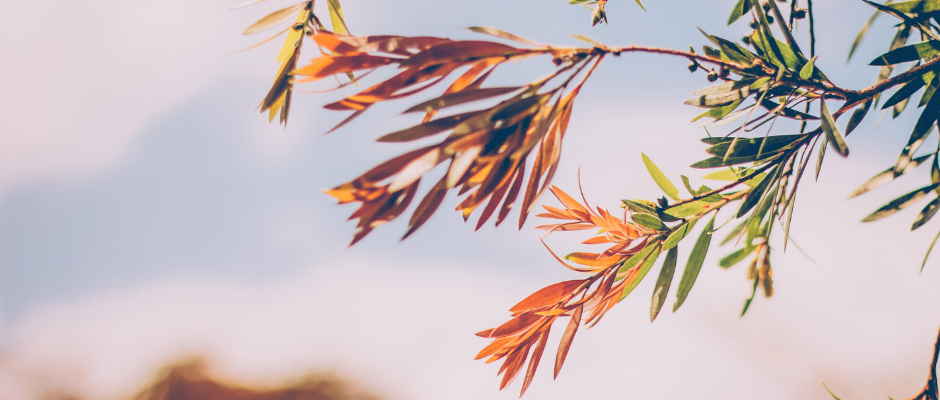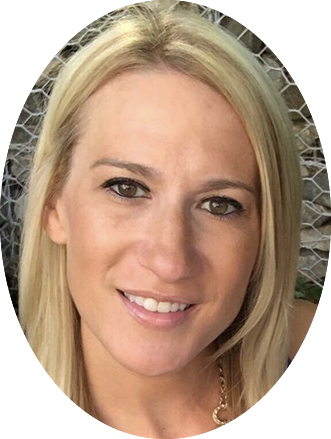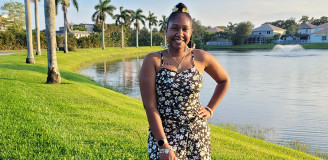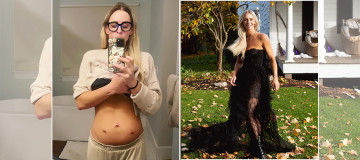
On March 9th, 2020, I was officially diagnosed with endometriosis, a diagnosis that my surgeon and I believe took 17 years. I was 33 years old, and after almost two decades of chronic pain and violently painful periods, I finally knew why.
Birth control had masked my symptoms for most of my life. I was put on it at age fifteen when my period pain became so debilitating that I would have to miss school or miss out on social events. Throughout high school, the pain would come on sharply and suddenly, and I would immediately feel like I was going to throw up.
Soon enough, the school nurse and I fell into a routine; she knew that when I walked in looking ghostly white, it was time to take the heating pad out, hand me an Advil, and make me call my mom because there was no way I could physically finish the school day. The routine did not end there. I have very vivid memories of laying in my shower for hours on end with the hot water beating down on my pelvic area with the hope that I could find relief. Eventually, I began taking a medical cocktail throughout my day that equaled eight to ten Advils mixed in with eight Midols and generally it produced zero relief.
For years, I complained of the pain, telling my doctors that over the counter medicine just didn’t work and explaining that for the first three days of my period, I was out of commission and physically not able to move. No matter what I said, I was told that it was normal, that I would “grow out of it”, and that birth control should continue to help.
In my very late 20’s, I was taken off birth control because it was giving me such bad migraines that would leave me bed ridden and vomiting for days. But as soon as I was taken off, my physical ailments and problems increased; it was clear that the birth control had masked my endo.
When I was 31, the pain started to come outside of my cycle. Suddenly, I was experiencing severe stabbing pain in both my pelvic area and lower back when I would ovulate, a week before my period, and, of course, during my period. If I was symptom free for five days of the month, I would chalk that up to a successful and “healthy” month. The more time went on, the worse the pain got, and unexpectedly, there were so many more symptoms that I had never experienced. But I swore that the unexplained digestive issues, severe bloating, nausea, diarrhea, occasional vomiting, bladder issues, migraines, severe pelvic and lower back pain, chronic fatigue (no matter how many hours I slept) and genital pain were not connected to my bad periods. I mean, how could they be when my gynecologist had said all of this was normal?
In order to manage my pain, I had heating pads in every room in my apartment as well as an attachable battery-operated heating pad that I could wear under my clothing while I was at work or when I was trying to socialize. Soon, it felt like my pain was taking over my life and it was taking a massive toll on me mentally and physically, but what struck me the most was that I was beginning to normalize the pain.
I started to plan my biggest life's events around when I would not have my period. When I got engaged, I pulled out the calendar immediately and mapped out when I would have my period each month for the next year to ensure, as best I could, that I would not have it on my wedding day. And while a lot of brides might do the same—I mean, who wants to wear white while they have their period?—I had to plan around it because I knew that the pain I would be in would render me unable to move, let alone enjoy my day with my husband.
But eventually something changed. I had begun to lean into this gut feeling that something was not right, so when my sister-in-law tagged me in a post on celebrity Mae Whitman’s Instagram page, I was astounded; her post about her endometriosis story, from her symptoms to her surgery, was almost identical to mine. I cannot describe the validation I felt when I read, “pain isn’t normal, there is hope and you are not alone.” Just then, a fire was lit under me. I was so tired of suffering, and doing so mainly in silence, and there had to be a change.
Over the next few months I bounced from doctor to doctor, but unfortunately, few of the ones that I saw knew anything about endometriosis. Even worse, I had doctors who gaslighted me,telling me that my pain was all in my head and how endometriosis would not cause pain in these other areas. Sadly, I actually started to believe what I was told, especially when my test results from CT scans, pelvic ultrasounds, abdominal ultrasounds, vaginal ultrasounds, pelvic MRIs, and hysterosalpingogram showed nothing but hemorrhagic cysts that would usually resolve on their own. Many of the tests were extraordinarily painful, which only made it more frustrating that I still was left with no answers.
After each appointment, I would call my husband in hysterics while retelling how each doctor would say, “if you have endometriosis, it will show up on your scans.” But I knew that something was wrong. In fact, I soon became living proof that what is understood about endometriosis is far from the whole picture. Endometriosis does not always show up on scans.
Finally, I decided to be my own health advocate because I knew what was happening to my body was not normal nor was it okay. Thankfully, I had been seeing a gastroenterologist for what I thought was stomach issues, and after running so many tests and finding nothing serious, he mentioned that I might want to look into endometriosis. It is still crazy to me that out of all of the women’s health doctors I had seen, he was the one who suggested I may have endometriosis.
Unfortunately, the only way to properly and officially diagnose this horrible disease is to have laparoscopic exploratory surgery, and before I finally found my surgeon, I was given so much conflicting information from different gynecologists. One said I was too young for the surgery, one said I was too old, one said it could affect fertility negatively, one said it was too dangerous, and yet again I was told it wasn’t necessary because it would have shown up on my scans.
And so for the next year and a half, I endured this uphill battle basically alone. Even though I had a great support system, none of them could ever possibly understand what I was going through. And while it was no one’s fault, it was exhausting to have to explain how I felt or teach them what they didn’t know, explaining to them that these “myths” they had heard of were affecting me. I wish I had a nickel for every person who suggested, "just get pregnant, the pain goes away then." Or even worse, "get a hysterectomy, not being able to have children seems like the lesser of two evils than being in constant pain." Believe it or not, that suggestion came from a medical professional. These are two of the most common misconceptions on how to treat endometriosis. What had already been isolating and lonely became even more so. That said, my husband stayed by my side, and I am eternally grateful to him. He witnessed my day-in and day-out struggles and his support never, and still has not, waivered.
Even still, I felt so alone. I was afraid to go places in the fear that my flare ups would be obvious to people, because sometimes my bloating would be so bad I looked six months pregnant, and I did not want to be embarrassed or have to explain. The fear that people didn’t believe me and thought I was dramatic or that I should get over it because all I was feeling was just “bad cramps” paralyzed me. How could they possibly understand that it felt like there was barbed wire in my pelvic area and that someone was in there playing tug-of-war constantly? How could they possibly understand that some days it was hard for me to walk because my back pain was now radiating down to my legs? In short, they couldn’t.
These feelings overwhelmed me and I knew that I had to figure it out. I began to research and sought help in more ways than one. I spoke to a friend about my continuous struggles and she suggested seeing a surgeon at the hospital she works at to get some answers. I also began talking to a therapist to process all of these feelings. Because I learned a lot along the way through my research about endometriosis, I felt I was as prepared as I could have been when I met my surgeon.
At our first meeting, he listened to me, understood my symptoms, confirmed that my pain was NOT normal and made a plan of action. It was the first time I felt heard and seen in 17 years, and it was the first time I had left a doctor’s office feeling some semblance of hope. My most important takeaway from our first meeting, however, was that he told me that this is not a one-size-fits-all disease. Every woman is different, and every woman’s outcome is different. He also specified that being a woman should not correlate to being in pain.
In what most of my friends call “Felicia luck,” my first two scheduled surgeries were cancelled, once because my surgeon had the flu and once because I had a stomach flu.
Finally, on March 9th, the day for surgery arrived. Although I didn’t know this then, it was right in the nick of time as the pandemic blew up just days later. I woke up in severe pain from surgery and I remember feeling so scared. I assumed there would be pain involved–it was a surgery after all–but I was not prepared for the extent of it. Pretty quickly they brought my husband back to see me and he was the one who delivered my diagnosis news to me as it was early evening at this point and my surgeon was no longer around. The words that came out of my husband’s mouth were, “Fe, you have stage one/stage two endometriosis. Your surgeon found it on your bladder, behind both of your ovaries and deeper in your uterus and colon. He removed all the lesions he found. He is hopeful, although he can’t guarantee, that we will be able to conceive one day because your tubes were open and the endo was not blocking them.”
This diagnosis was the most bittersweet thing to ever happen to me. I felt validation that the pain I have felt for close to twenty years was real, and yet I also felt an overwhelming sadness knowing that I will have this disease for the rest of my life; even though he removed it, it could grow back. All I could do was cry for both the validation and reality of the diagnosis. The tears just wouldn’t stop.
Since being diagnosed with endometriosis, I have also been diagnosed with other health issues that seem to be common in women with endometriosis. I go to pelvic physical therapy weekly, as well as acupuncture, and I have put myself on a low inflammation diet that includes no gluten, dairy, soy, and very little sugar and alcohol. I do not have all the answers, but I am willing to do whatever it takes to feel better.
At the end of the day, it's hard for me to understand how so many women suffer from this, but yet there is not enough awareness. One in ten women have this awful disease, yet most women don’t even know it exists. I am one in ten. Someone you know has it; maybe someone you know has it and they don’t even know. There are asymptomatic cases. The average onset of diagnosis is eight to ten years. Some women will have an average of seven to ten surgeries in their lifetime.
I often wonder how is it possible that in 2020, while the world is advancing every day, women still have to struggle with a disease that will always grow back, even after it is removed; how women have to deal with the fact that their disease currently has no cure; and how women have to understand that this disease might make them infertile.
I read a statistic the other day that said 176 million women in the world have endometriosis but there are only 200 skilled excision surgeons out there. These facts and stats make me angry, but mostly they just make me want to make a difference any way I can.
Having endometriosis has made me much more empathetic to other people's struggles, and to understand that sometimes it is okay to not be okay.
By sharing my story now, after a long time of resisting doing so, I have decided to reframe my way of thinking, hoping to encourage others to do the same.
Instead of feeling weak because we suffer through this, I want us to feel empowered because we are strong, because we live through daily chronic pain and still try to manage a “normal life.” If we are having a bad day or bad flare, we need to allow our bodies to rest. We need to stop worrying about what other people think of us. We must remember that their perspective is a reflection on them and not on us.
Most of all, I want women to know that they are not alone. I hear you, I see you, and I am here for you. And together we are all Endo Strong.
 Felicia Maiello is 34 years old and resides in Bergen County, NJ. She was officially diagnosed with endometriosis in March of 2020 at the age of 33 but has struggled with symptoms and the disease for 17 years. Though she is still not pain-free, she continues to seek out whole body care through holistic healing as she believes that the mind and body are connected; she is working to find a balance between the two. Since her diagnosis, she is working to make a difference with this disease and is trying to raise awareness through her own platform and others. Finding Endofound and sharing her story is her first step, but her hope is that the next generation of women will not have to suffer as long, and will get a proper diagnosis sooner as well as more options for care. It is her hope that it will be taught in Health classes so that every girl and young woman knows what it is and what their treatment options are. She also hopes to maybe one day speak to large audiences as a means to spread awareness on this disease and to change the perspectives of people all over the world.
Felicia Maiello is 34 years old and resides in Bergen County, NJ. She was officially diagnosed with endometriosis in March of 2020 at the age of 33 but has struggled with symptoms and the disease for 17 years. Though she is still not pain-free, she continues to seek out whole body care through holistic healing as she believes that the mind and body are connected; she is working to find a balance between the two. Since her diagnosis, she is working to make a difference with this disease and is trying to raise awareness through her own platform and others. Finding Endofound and sharing her story is her first step, but her hope is that the next generation of women will not have to suffer as long, and will get a proper diagnosis sooner as well as more options for care. It is her hope that it will be taught in Health classes so that every girl and young woman knows what it is and what their treatment options are. She also hopes to maybe one day speak to large audiences as a means to spread awareness on this disease and to change the perspectives of people all over the world.
Editor's note: Would you like to contribute to EndoStories? Click here to learn how to submit your work.
*Patient stories submitted to EndoFound.org are the views of the patient and not necessarily those of the foundation. All testimonials are from real patients, and may not reflect the typical patient’s experience, and are not intended to represent or guarantee that anyone will achieve the same or similar results.









